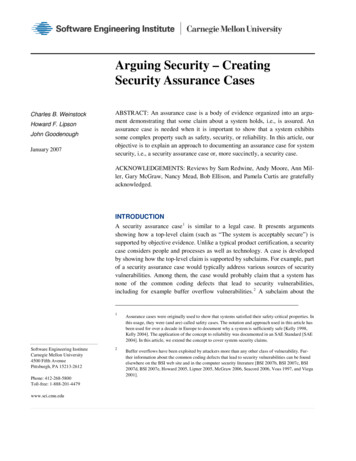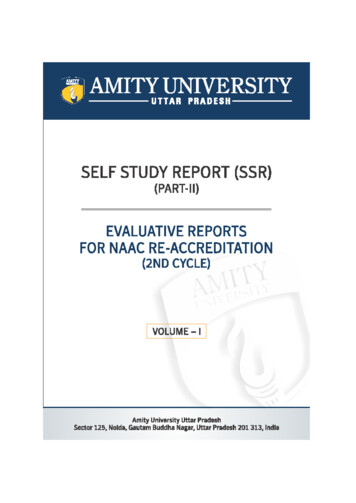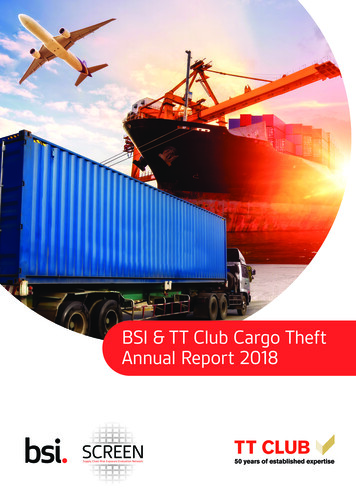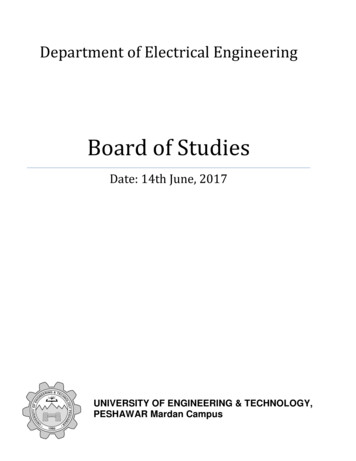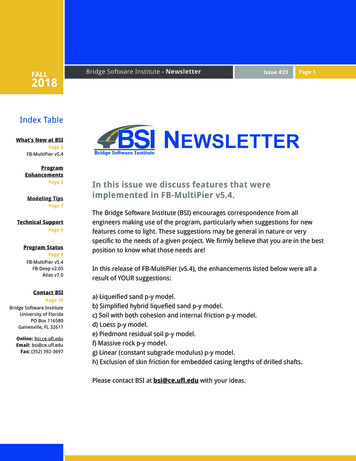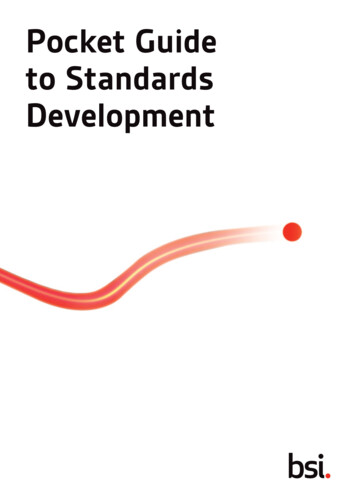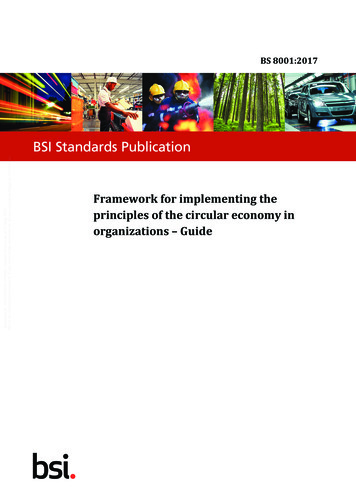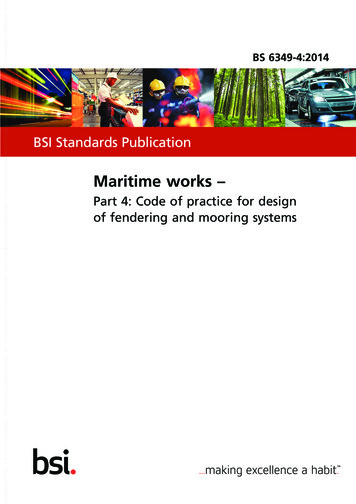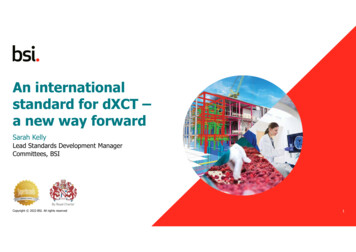
Transcription
BS 0:2016BSI Standards PublicationA standard for standards –Principles of standardization
BS 0:2016BRITISH STANDARDPublishing and copyright informationThe BSI copyright notice displayed in this document indicates when the documentwas last issued. The British Standards Institution 2016Published by BSI Standards Limited 2016ISBN 978 0 580 94429 1ICS 01.120The following BSI references relate to the work on this document:Committee reference SPSCDraft for comment 16/30342350 DCPublication historyFirst published as Part 1, Part 2, Part 3 and Part 4, February and March 1974Second edition of Part 4, December 1975Part 1 and Part 3 first published as Part 1 and Part 2, November 1981Part 2 and Part 4 first published as Part 3, November 1981Third edition of Part 1 and Part 2, October 1991Second edition of Part 3, November 1991Fourth edition of Part 1 and Part 2 and third edition of Part 3, August 1997Part 1 and Part 2 first published as Part 1 and Part 3 first published as Part 2,December 2005First edition as a single part, August 2011Second (present) edition, December 2016Amendments issued since publicationDateText affected
BRITISH STANDARDBS ative references23Terms and definitions244.14.24.34.4Principles of standardization 7Context and purpose 7The National Standards Body 8Application of standards 9Transparency 1055.15.25.35.45.55.65.75.8Development of British Standards 10Principles 10New work 11International standardization 12European standardization 13Common features of international and European standardization 13UK participation in international and European standardization 14British Standards of UK origin 15Consultation – Draft for public comment (DPC) 1566.16.2Publishing and maintaining standardsPublication 15Maintenance 1677.17.27.37.47.57.67.77.87.97.107.11BSI committees 17Principles 17Committee constitution 18Nominating organizations 19Co-option for specific tasks 20Decision making 20Minutes 21Disputes 22Legal advice 22External communication 22Delegation of responsibilities 23Intercommittee liaison 2388.18.28.38.48.58.68.78.8Roles and responsibilities 23BSI 23BSI staff 24Conduct 24Committee members 24Committee chairs 25Panels for national standards 26Committee secretaries 27Feedback and comments 2799.19.29.39.49.5Content and drafting of standards 28Principles 28Relationship with the law 28Drafting 29Types of standardization publication 30Intellectual property rights (IPR) 3115 The British Standards Institution 2016 i
BS 0:2016BRITISH STANDARDAnnexesAnnex A (informative) Glossary of common terms in standardizationBibliographyIndex343940List of figuresFigure 1 – Stages of standards development, publication and maintenanceSummary of pagesThis document comprises a front cover, an inside front cover, pages i to iv,pages 1 to 44, an inside back cover and a back cover.ii The British Standards Institution 201611
BRITISH STANDARDBS 0:2016ForewordPublishing informationThis British Standard is published by BSI Standards Limited, under licence fromThe British Standards Institution, and came into effect on 31 December 2016. Itwas prepared on behalf of the BSI Standards Policy and Strategy Committee.SupersessionThis British Standard supersedes BS 0:2011, which is withdrawn.Contractual and legal considerationsThis publication does not purport to include all the necessary provisions of acontract. Users are responsible for its correct application.Compliance with a British Standard cannot confer immunity from legalobligations. The British Standards Institution 2016 iii
BS 0:2016iv The British Standards Institution 2016BRITISH STANDARDThis page deliberately left blank
BRITISH STANDARDBS 0:2016IntroductionBS 0, A standard for standards, is the main document by which BSI sets out howBritish Standards and related documents are developed and maintained.The principal changes introduced in this edition of BS 0 are as follows: clarification of roles and responsibilities; the addition of information on panels for national standards; new details for submitting feedback and comments.Certain topics regularly arise during any revision of BS 0, and it was decided: to retain the “z” spelling usage (e.g. “standardization”) for consistency withthe preferred variant listed in the Shorter Oxford English Dictionary, notingalso that it is the traditional English usage rather than an Americanism; to retain the decimal point in preference to the decimal comma, noting thatit reflects the overwhelmingly predominant practice in the UK and isinconsistent with many international and European standards that areadopted without change by BSI; and to retain the “f” spelling of “sulfur” and its derivatives, noting that it is theagreed variant adopted by the International Union of Pure and AppliedChemistry (IUPAC) and most analogous professional bodies in the UK, andreflects the general usage of most of those in the UK scientific community.1 ScopeThis British Standard sets out the principles of standardization undertaken bythe British Standards Institution (BSI) in its role as the UK National StandardsBody (NSB).The principles encompass the development, publication, maintenance andapplication of British Standards and related standardization documents,together with the UK’s participation in European and internationalstandardization.The principles set out in this document do not include discussion of BSI’snon-NSB activities, nor detailed discussion of the rules and procedures of theinternational and European standardization bodies. The British Standards Institution 2016 1
BS 0:2016BRITISH STANDARD2 Normative referencesThe following documents, in whole or in part, are normatively referenced in thisdocument and are indispensable for its application. For dated references, onlythe edition cited applies. For undated references, the latest edition of thereferenced document (including any amendments) applies. 1)[N1]ISO/IEC Directives, Part 2:2016, Rules for the structure and drafting ofInternational Standards [www.iso.org/directives 2)][N2]CEN/CENELEC Internal Regulations, Part 3, Rules for the structure anddrafting of CEN/CENELEC publications [www.cen.eu/boss 2)][N3]BSI, Rules for the structure and drafting of UK standards[www.bsigroup.com 2)]3 Terms and definitionsFor the purposes of this British Standard, the following terms and definitionsapply.NOTE3.1Additional terms, abbreviations and definitions are given in Annex A.amendmentalteration and/or addition to previously agreed technical or editorial content ofan existing standard3.2British StandardBSstandard, developed and published by BSI following the principles set out in thisstandard3.3BSI Boardgoverning body of BSI3.4European Committee for StandardizationCENEuropean standards body, of which BSI is the UK member, officially recognizedby the European Union and the European Free Trade Association3.5European Committee for Electrotechnical StandardizationCENELEC CLCEuropean standards body, of which BSI is the UK member, officially recognizedby the European Union and the European Free Trade Association forstandardization in the area of electrotechnical engineering3.6CEN/CENELEC enquirystage of the development process at which a draft standard (prEN) is distributedby the CEN/CENELEC Management Centre to CEN or CENELEC national membersfor public consultation3.7chairformally appointed leader of a committee1)2)2 This clause, which contains standard wording used for all European and internationalstandards, is intended to identify all other documents to which reference might needto be made in the application of this standard. In practice, it might be possible toapply this and many other standards without recourse to all or any such externalreferences.Last viewed 13 December 2016. The British Standards Institution 2016
BRITISH STANDARD3.8BS 0:2016committeeNOTE The term “committee” is used in this standard to refer to both technicalcommittees (3.8.1) and subcommittees (3.8.2). It does not refer to any otheradministrative or governance committee of BSI.3.8.1technical committeeTCbody responsible for a particular area of standards work3.8.2subcommitteeSCsubordinate committee of a technical committee3.8.3UK mirror committeenational mirror structure to the European/international technical committees,ensuring the formulation of coherent national positions3.9committee memberperson serving on a BSI committee or panel3.10common modificationalteration, addition to or deletion from the content of a reference document,approved by CEN/CENELEC and thus forming part of the EN (and HD forCENELEC)[CEN/CENELEC Internal Regulations, Part 2:2015, definition 2.14] [1]3.11complianceaction of a person or body in fulfilling provisionsNOTE3.12See also 3.13.conflict of interestsituation in which, because of other activities or relationships, transparent andeffective representation of declared interests, or of a mandated brief, is or couldbe compromised3.13conformityfulfilment of a provision[BS EN ISO 9000:2005, definition 3.6.1, modified]NOTE3.14See also 3.11.consensusgeneral agreement, characterized by the absence of sustained opposition tosubstantial issues by any important part of the concerned interests and by aprocess that involves seeking to take into account the views of all partiesconcerned and to reconcile any conflicting argumentsNOTEConsensus need not imply unanimity.[ISO/IEC Guide 2:2004, definition 1.7] [2]3.15consumerindividual member of the general public purchasing or using property, productsor services for private purposes[BS ISO 26000:2010, definition 2.2] The British Standards Institution 2016 3
BS 0:2016BRITISH STANDARD3.16corrigendumalteration and/or addition to a standard that corrects one or more errors orambiguities inadvertently introduced in either drafting or production and whichcould lead to incorrect or unsafe application of the publication3.17decision-making processtransactions of a committee or panel directly related to establishing whetherconsensus has been reached on any particular matter requiring a decision3.18delegaterepresentative of a national standards body to a committee of an internationalor European standards bodyNOTE3.19The representative is usually a committee member.draft for public commentDPCstage in the development of a British Standard at which wider consultation issought3.20draftstandard or other deliverable under development3.21European standardENstandard adopted by CEN/CENELEC and carrying with it an obligation ofimplementation as an identical national standard and withdrawal of conflictingnational standards[CEN/CENELEC Internal Regulations, Part 2:2015, definition 2.5] [1]NOTE3.22A European Standard produced by ETSI carries with it the same obligations.essential intellectual property rightsessential IPRintellectual property rights that have been included within a standard such thatit would be impossible to implement the standard without making use of thoserights, and the only way to avoid an infringement of the rights in respect ofimplementation of the standard is therefore to request a licence from the owner3.23European Telecommunications Standards InstituteETSIEuropean standards body officially recognized by the European Union and theEuropean Free Trade Association for standardization in the area oftelecommunications3.24expertperson nominated from a national committee to contribute to the detailed workof a working group (or similar body) in ISO, IEC, CEN or CENELEC3.25formal votestage of the development process at which the final text of a prEN (FprEN) iscirculated by the CEN/CENELEC Management Centre to national members forapproval by weighted voting3.26International Electrotechnical CommissionIECinternational standards body for standardization in the area of electrical andelectronic technology and engineering, of which BSI is the UK member4 The British Standards Institution 2016
BRITISH STANDARD3.27BS 0:2016IEC Conformity Assessment BoardIEC/CABbody responsible for setting the IEC’s conformity assessment policy, reporting tothe IEC Council Board3.28informativecharacteristic of material in a standard that supplements normative material byoffering advice, information and guidance3.29international standardISO or IEC standard3.30intellectual property rightsIPRrights having no tangible form, but representing the product of creative work orinventionNOTE3.31Such rights include: copyright and related rights, rights in designs; patents, rights to inventions, whether registered or unregistered.Internal Regulations (of CEN/CENELEC)IRrules of the European standards bodies3.32International Organization for StandardizationISOinternational standards body, of which BSI is the UK member3.33ISO Conformity Assessment CommitteeISO/CASCOISO’s policy development committee on conformity assessment, reporting tothe ISO Council3.34normativecharacteristic of material in a standard that is essential to the application of thestandard in the manner intended, and against which it is possible todemonstrate and claim conformity to the standard3.35normative referencedocument to which reference is made in a standard in such a way as to make itindispensable for the application of the standard3.36panelsubordinate group of a BSI technical committee or subcommittee, responsiblefor specific delegated tasks, broadly equivalent to an international or EuropeanWorking GroupNOTE Panels are led by a convenor, who does not have the authority of a formallyappointed chair.3.37provisionnormative element of a standard3.38regulationdocument providing binding legislative rules, that is adopted by an authority[ISO/IEC Guide 2:2004, definition 3.6] [2] The British Standards Institution 2016 5
BS 0:2016BRITISH STANDARD3.39Standards Policy and Strategy CommitteeSPSCpolicy committee established by the BSI Board to advise it as appropriate onmatters of standardization policy and strategy and to oversee all workundertaken in BSI committees3.40standarddocument, established by consensus and approved by a recognized body, thatprovides, for common and repeated use, rules, guidelines or characteristics foractivities or their results, aimed at the achievement of the optimum degree oforder in a given contextNOTE Standards should be based on the consolidated results of science, technologyand experience, and aimed at the promotion of optimum community benefits.[ISO/IEC Guide 2:2004, definition 3.2] [2]3.41standardizationactivity of establishing, with regard to actual or potential problems, provisionsfor common and repeated use, aimed at the achievement of the optimumdegree of order in a given contextNOTE 1 In particular, the activity consists of the processes of formulating, issuingand implementing standards.NOTE 2 Important benefits of standardization are improvement of the suitability ofproducts (including services) and processes for their intended purposes, preventionof barriers to trade and facilitation of technological co-operation.[ISO/IEC Guide 2:2004, definition 1.1] [2]3.42standard of UK originBritish Standard developed within the UK3.43standstillobligation accepted by the members of CEN/CENELEC/ETSI not to take anyaction, either during the preparation of a European standard or after itsapproval, which could prejudice the intended harmonization or endanger theprogress of work at European level and, in particular, not to publish a new orrevised conflicting national standard3.44Technical ReportTRdocument published by ISO, IEC, CEN or CENELEC containing informativematerial not suitable to be published as a standard or a Technical SpecificationNOTE A TR may include, for example, data obtained from a survey carried outamong the national members, data on work in other organizations, or data on thestate of the art in relation to national standards on a particular subject.3.45Technical SpecificationTSdocument published by ISO, IEC, CEN or CENELEC about which there is thepossibility of future approval as a standard, but for which at present there arereasons precluding immediate publication as a standardNOTE Typically the reasons for this would be that the required support for suchapproval cannot be obtained; there is doubt on whether consensus has beenachieved or the subject matter is still under technical development.3.46vote ballotprocess of approval undertaken for specific purposes by international andEuropean standards bodies6 The British Standards Institution 2016
BRITISH STANDARD3.47BS 0:2016working groupWGgroup of experts, appointed by an international or European technicalcommittee or subcommittee, responsible for drafting documents3.48work itemWIstandards project3.49work programmedetailed list of all subjects (work items) to be developed within the scope of atechnical committee, forming a group of interrelated standards projects whichtogether achieve a common purpose in support of the strategic aims of atechnical committee4 Principles of standardization4.14.1.1Context and purposeContextStandards exist principally to provide a reliable basis on which commonexpectations can be shared regarding specific characteristics of a product, serviceor process.4.1.2PurposesThe purposes of British Standards include:4.1.3a)facilitating trade, particularly in reducing technical barriers and artificialobstacles to international trade;b)providing a framework for achieving economies, efficiencies andinteroperability;c)enhancing consumer protection and confidence; andd)supporting public policy objectives and, where appropriate, offeringeffective alternatives to regulation.British StandardsAll British Standards have the defining characteristics of:4.1.4a)representing good practice as defined by experts;b)development by balanced and broadly representative standing committeesthat retain responsibility for them indefinitely, and that reach agreement byconsensus;c)being made subject to unrestricted open consultation; and,d)remaining subject to systematic periodic review as to their continuingvalidity.Voluntary statusBritish Standards are voluntary in that there is no obligation to apply them orcomply with them, except in those few cases where their application is directlydemanded by regulatory instruments. They are tools devised for the convenienceof those who wish to use them. In certain circumstances the actions of thirdparties might have the effect of making the application of a standard acommercial necessity, e.g. in a contract, but BSI has no control over these actionsand is not a party to them. The British Standards Institution 2016 7
BS 0:2016BRITISH STANDARD4.1.5Authority and reliabilityFor a British Standard to be a useful and attractive tool for conducting businessor supporting public policy, it has to command the trust and respect of all thosewho are likely to be affected by it.The reliability of a British Standard rests not just on its technical accuracy andthe sound judgement of those responsible for its text. There needs also to be awidely held confidence that:a)it is desirable, practical and authoritative;b)it offers no particular nor exclusive advantage to any party;c)it serves the needs of the wider community;d)in application it will be consistent with regulations and legal principlesestablished at the time of publication.The measures that are necessary to underpin this confidence are set outin Clause 5. It is the responsibility of all parties involved in the development of astandard to ensure that these are not compromised.4.1.6Adherence to BS 0Adherence to the principles set out in BS 0 is a condition of participating in anycapacity in the development of British Standards.4.24.2.1The National Standards BodyStandards developmentBSI has a role as the UK National Standards Body (NSB). This is established underits Royal Charter and codified in the Memorandum of Understanding betweenthe United Kingdom Government and the British Standards Institution (theMoU). The role includes co-ordinating and facilitating the development ofstandards of UK origin, as well as being the UK focus for participation inEuropean and international standardization. This is through the InternationalOrganization for Standardization (ISO) and the International ElectrotechnicalCommission (IEC), together with regional (i.e. European) standards produced bythe European Committee for Standardization (CEN) and the EuropeanCommittee for Electrotechnical Standardization (CENELEC).BSI is also responsible for co-ordinating and facilitating the development ofother types of standardization document, notably Technical Specifications (TSs)and Technical Reports (TRs). These do not share all the same definingcharacteristics, and they are therefore not to be regarded as British Standards(see 9.4.2).NOTE BSI is appointed as the National Standards Organization (NSO) for ETSIactivities in the UK. Specific details of BSI involvement in this work can be found inthe Memorandum of Understanding between ETSI and the NSOs (seehttp://portal.etsi.org/nso/revised nov02.asp 3)).BSI’s NSB role also entails responsibility for publishing and promoting thestandards that it develops. It maintains an infrastructure such that:a)each of its standards is routinely reviewed; andb)concerns about the content of a standard can be investigated and actedupon.3)8 Last viewed 13 December 2016. The British Standards Institution 2016
BRITISH STANDARD4.2.2BS 0:2016ResourcingStandardization projects impose considerable demands on the resources of allthose involved in them. It is BSI’s responsibility to apply its resources taking intoaccount the benefits that are likely to accrue from each project in the context ofits overall work programme.It is also necessary to be conscious of the resources of others involved in thework, particularly in terms of travel and attendance at meetings.Face-to-face meetings of committees should be convened only for thosepurposes that are difficult to achieve by other means, e.g. web conference,teleconference, correspondence.4.34.3.1Application of standardsPrinciples of applicationResponsibility for selecting and applying a standard lies with its user. In general,BSI is not able to assist in this (nor take any responsibility for it) other than totry to provide an indication of the scope and content of a standard. In somecircumstances, BSI might develop formally published guidance documents on theapplication of a particular standard or set of standards.Standards are drafted in the expectation that those who use them will beappropriately experienced, qualified and equipped to do so, that they will applythem conscientiously and, where necessary, take sound advice by othersqualified to provide it.4.3.2InterpretationResponsibility for interpreting a standard rests with its user, informed wherenecessary by appropriate expert advice. Ultimately, the only body with thepower to give a definitive interpretation is a court of law.To avoid undermining the basis for common expectations set out in 4.1.1, BSIdoes not offer individual interpretations of standards.However, any ambiguities, inconsistencies or possible errors notified to BSI willbe referred for consideration by the committee responsible for the standard, aswill any proposals for changes or improvements. These notifications are activelyencouraged as a contribution to the maintenance of a document (see also 6.2.1).4.3.34.3.3.1Declarations of compliance and conformityPrinciplesDeclarations that an individual or organization has complied with the provisionsof a standard, or that a product or service conforms to a standard (otherwisetermed “conformity attestation”), are entirely the responsibility of those makingsuch declarations (see also 4.3.4).Not all standards can support such claims in a meaningful way (see 9.4). Thosethat can (or do), however, have to be drafted such that a valid claim can bemade. Further information on conformity assessment is given in ISO/IECDirectives, Part 2:2016 [N1], Clause 33.BSI committees should refer conformity assessment issues to the ConformityAssessment Policy Committee in the first instance, which can refer an issue toISO/CASCO or IEC/CAB if necessary. The British Standards Institution 2016 9
BS 0:2016BRITISH STANDARD4.3.3.2Third-party conformity assessmentAs a long-standing principle of public policy, it is generally not acceptable for astandard to state that a legitimate claim of compliance is dependent onthird-party conformity assessment. There are certain established derogationsfrom this principle, and if, exceptionally, it is believed that a circumstance hasarisen where a standard will need to include a requirement for third-partyconformity assessment, the approval of SPSC is required.Standards may be developed to support an identified market need forthird-party conformity assessment. In these cases:a)the existence of, or the feasibility of, third-party conformity assessmentshould be established before the project is approved;b)the standard may not be explicitly linked to any individual conformityassessment scheme; andc)advice from at least one conformity assessment provider should be soughtduring the drafting process.Beyond its NSB role, BSI provides commercial conformity assessment services. It istherefore imperative that all procedures and transactions surrounding thedevelopment of standards that might be used to support third-party assessmentschemes are demonstrably independent of any commercial interest that BSImight have.4.3.4Market surveillanceBSI is not empowered, nor resourced, nor qualified to conduct marketsurveillance or to examine allegations of false claims of compliance with astandard. Such cases should usually be referred in the first instance to therelevant market surveillance authority (MSA) for the matter in question. In thecase of most consumer goods this is the trading standards unit of the localauthority in which the allegation arose.4.4TransparencyAs part of BSI’s commitment to the transparency and accountability of thestandardization process, the principal documents associated with the workprogramme of the committee, including notes of decisions made at committeemeetings, will be made available on request with the exception of documentsthat are potentially sensitive, such as briefing papers, or of potential commercialvalue, or that are subject to restrictions by their originating organizations.The identities of the organizations represented on a committee are in the publicdomain. To protect against lobbying or media attention, the identities ofindividuals are confidential.5 Development of British Standards5.1PrinciplesThe principles underpinning the development of British Standards are set outin 4.1 and 4.2 and are discussed in further detail in Clause 7.The majority of documents published as British Standards have their origin ininternational standards (developed by ISO and IEC) or European standards(developed by CEN and CENELEC, often in partnership with their internationalcounterparts). The remainder are developed exclusively by BSI to meet particularneeds in the UK.10 The British Standards Institution 2016
BRITISH STANDARDBS 0:2016From a UK perspective, the focus for all three development streams is the BSItechnical committee responsible for the relevant area of work (see 7.1).The principles of development for each type of document are broadly similar,but there are some important procedural differences which are covered in 5.3and 5.4.The steps involved in the development, publication and maintenance of BritishStandards are shown in Figure 1.Figure 15.2Stages of standards development, publication and maintenanceNew workAnyone, whether an individual, or a corporate or collective or public body, canpropose a new British, European or international standard, or the revision of anexisting one.A proposer is expected to be able to demonstrate:a)a broadly based need for the proposed standard;b)that the work is likely to have active support from a wide range of relevantinterests.BSI will assess whether:1)there are enough resources to provide an initial draft and complete theproject within a reasonable timescale;2)any conflict would exist with any British Standard or European standard,either published or in development (see 5.4), consulting technicalcommittees as appropriate.NOTE The “reasonable timescale” for completion of a project will vary according toits complexity and the breadth of consensus that needs to be established. Less than ayear is rarely achievable; more than three years is rarely acceptable. The British Standards Institution 2016 11
BS 0:2016BRITISH STANDARDIt is also expected that detailed consideration will have been given to the typeof publication (see 9.4) best suited to achieve the intended purpose and that theproposal will be accompanied by a draft scope statement (see 9.3.3).All such proposals are evaluated against these criteria, also taking into accountstrategic priorities and resourcing. Where considered appropriate, widerconsultation and impact assessment might be undertaken.Proposals specifically for projects to be undertaken at international or Europeanlevel are also subject to approval by the UK mirror committee (see 5.6) and tothe approval process of the relevant international or European standardizationbody.The international and European processes entail consultation with nationalbodies to establish whether there is:i)a market demand for the proposed standard; andii)sufficient resource available to allow the project to be undertakenefficiently.The outcome of the consultation is expressed as a national vote as to thedesirability and feasibility of the proposal.All new work approved is announced publicly with a view to attracting a widerange of involvement in its development.Most projects are accepted onto the work programme on the basis of the scopestatement originally submitted (see also 9.3.3). Subsequent significant changesto the scope can have an impact on the feasibility or desirability of a project andcan result in the work being s
This British Standard is published by BSI Standards Limited, under licence from The British Standards Institution, and came into effect on 31 December 2016. It was prepared on behalf of the BSI Standards Policy and Strategy Committee. Supersession This British Standard supersedes BS 0:2011, which is withdrawn. Contractual and legal considerations
